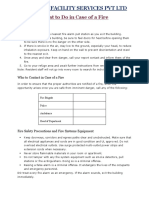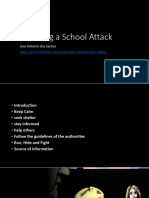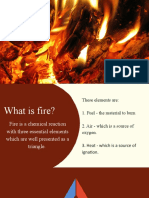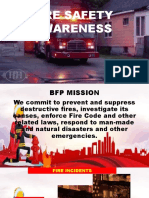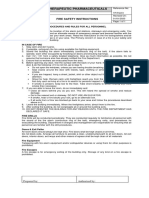0 ratings0% found this document useful (0 votes)
25 viewsAction in Case of Fire
Action in Case of Fire
Uploaded by
Hemanth NairThe document provides guidance on what to do and not do in case of a fire. It lists actions like raising an alarm, trying to extinguish small fires with the proper extinguisher if safe to do so, evacuating if the fire grows or one's means of escape is blocked, and calling the fire department with details on the location and fire. The document advises against actions like running in panic, tampering with equipment, crowding the fire scene, or using the wrong type of extinguisher on a fire.
Copyright:
© All Rights Reserved
Available Formats
Download as PPT, PDF, TXT or read online from Scribd
Action in Case of Fire
Action in Case of Fire
Uploaded by
Hemanth Nair0 ratings0% found this document useful (0 votes)
25 views4 pagesThe document provides guidance on what to do and not do in case of a fire. It lists actions like raising an alarm, trying to extinguish small fires with the proper extinguisher if safe to do so, evacuating if the fire grows or one's means of escape is blocked, and calling the fire department with details on the location and fire. The document advises against actions like running in panic, tampering with equipment, crowding the fire scene, or using the wrong type of extinguisher on a fire.
Original Description:
action in case of fire
Original Title
5. Action in Case of Fire
Copyright
© © All Rights Reserved
Available Formats
PPT, PDF, TXT or read online from Scribd
Share this document
Did you find this document useful?
Is this content inappropriate?
The document provides guidance on what to do and not do in case of a fire. It lists actions like raising an alarm, trying to extinguish small fires with the proper extinguisher if safe to do so, evacuating if the fire grows or one's means of escape is blocked, and calling the fire department with details on the location and fire. The document advises against actions like running in panic, tampering with equipment, crowding the fire scene, or using the wrong type of extinguisher on a fire.
Copyright:
© All Rights Reserved
Available Formats
Download as PPT, PDF, TXT or read online from Scribd
Download as ppt, pdf, or txt
0 ratings0% found this document useful (0 votes)
25 views4 pagesAction in Case of Fire
Action in Case of Fire
Uploaded by
Hemanth NairThe document provides guidance on what to do and not do in case of a fire. It lists actions like raising an alarm, trying to extinguish small fires with the proper extinguisher if safe to do so, evacuating if the fire grows or one's means of escape is blocked, and calling the fire department with details on the location and fire. The document advises against actions like running in panic, tampering with equipment, crowding the fire scene, or using the wrong type of extinguisher on a fire.
Copyright:
© All Rights Reserved
Available Formats
Download as PPT, PDF, TXT or read online from Scribd
Download as ppt, pdf, or txt
You are on page 1of 4
ACTION IN CASE OF FIRE
DONTs -IN CASE OF FIRE
Dont run in panic.
Dont take undue risk.
Dont tamper with electrical installation, air-conditioning
system etc during Fire Fighting. Leave them for authorized
handling.
Dont argue or discuss on the scene of fire.
Dont linger with the equipment if you do not know its
operation and keep away or ask someone nearby.
Dont crowd the scene of fire
Dont resort to breaking, cutting, unless required.
Dont use all types of extinguishes on one fire.
Dont use water on electrical fire.
DOS- IN CASE OF FIRE :
Raise alarm or shout FIRE at the peak of your
tone, if you notice a fire within your vicinity.
Approach the scene within the quickest possible
time.
Try to attract others attention as far as possible
on your way to the scene of fire.
If you are first to reach, make sure that no life is
trapped.
Try to put off the fire with the nearest appropriate
type of extinguisher.
As other rush to the scene, tell them what is the
type of fire and which extinguisher to use.
Contd.
Dos in case of fire contd.
Do arrange, to put off the supply in case of electrical
fires, do not take any chance.
Dial telephone number of Fire Station and other key
personnel and give exact location and the item,
which has caught fire.
Open all doors and windows after the fire is
completely extinguished to avoid inhalation of any
fumes.
Keep yourself posted with information from time to
time.
DONT FIGHT FIRE IF FOLLOWING CONDITIONS EXIST:
If you dont know what is burning.
The fire is spreading rapidly.
You are not having any proper equipment.
The fire might block your means of escape.
You might inhale toxic smoke.
If you are not confident to do so.
If your first attempt to fight fire has failed, evacuate
immediately.
Doors should be closed as soon as the last person
leaves the room or area.
Dont use lifts, elevators. Use building stairs.
You might also like
- Fire Safety BasicsDocument30 pagesFire Safety Basicsashwinsid6645No ratings yet
- Fire Warden DutiesDocument18 pagesFire Warden DutiesvijithNo ratings yet
- Fire Safety BasicsDocument30 pagesFire Safety BasicsMehul PatelNo ratings yet
- Fire Safety 1Document23 pagesFire Safety 1Mohammad AshpakNo ratings yet
- Topic 6 - Basic Fire SafetyDocument29 pagesTopic 6 - Basic Fire SafetyEric BeckhamNo ratings yet
- UCSPDocument18 pagesUCSPRizalyn Lopez ParasNo ratings yet
- Elements of Fire: Fire - The Active Principle of Burning, Characterized by The Heat and Light of Combustion. It Is ADocument2 pagesElements of Fire: Fire - The Active Principle of Burning, Characterized by The Heat and Light of Combustion. It Is AMichael Pineda HervozaNo ratings yet
- Fire Instructions - Mac DonaldDocument1 pageFire Instructions - Mac DonaldJeetinder Singh ArriNo ratings yet
- What To Do in Case of FireDocument13 pagesWhat To Do in Case of FireBuug Fire StationNo ratings yet
- In Case of FireDocument1 pageIn Case of FireedwardNo ratings yet
- In Case of EmergencyDocument1 pageIn Case of EmergencyarkeiosNo ratings yet
- Response Procedure During A Fire IncidentDocument33 pagesResponse Procedure During A Fire IncidentJohn Lloyd GenerosoNo ratings yet
- Fire Safety: Nikunj Vekariya (U11Ce086) Chirag Varshney (U11Ce083)Document24 pagesFire Safety: Nikunj Vekariya (U11Ce086) Chirag Varshney (U11Ce083)Vasu MevawalaNo ratings yet
- Fire Safety and Fire Extinguisher UseDocument27 pagesFire Safety and Fire Extinguisher Usemanisha deivandranNo ratings yet
- Fire SafetyDocument36 pagesFire SafetyEunnice M. MagculangNo ratings yet
- 13 Fire SafetyDocument12 pages13 Fire SafetyElmer TamayaoNo ratings yet
- Advance Fire FightingDocument140 pagesAdvance Fire Fightinghamza100% (2)
- BAsic Fire Safety HandoutDocument4 pagesBAsic Fire Safety HandoutUgandhar Phani Varma PenmatsaNo ratings yet
- Fire Awareness PresentationDocument37 pagesFire Awareness Presentationshailu178No ratings yet
- Fire Safety 4Document19 pagesFire Safety 4eko ajiNo ratings yet
- Tips PDFDocument1 pageTips PDFapi-451594946No ratings yet
- Surviving A School AttackDocument12 pagesSurviving A School Attackliyajip105No ratings yet
- FT - TOPIC 5 - Fire Safety PresentationDocument26 pagesFT - TOPIC 5 - Fire Safety PresentationKervin SangalangNo ratings yet
- UntitledDocument18 pagesUntitledPearl MoresNo ratings yet
- Disaster Management TrainingDocument58 pagesDisaster Management TrainingBatish HakimNo ratings yet
- Fire Safety Lecture 2023Document92 pagesFire Safety Lecture 2023Bfp Dos Tuguegarao CagayanNo ratings yet
- Resedfiresafetytraining-Rev March 2016Document30 pagesResedfiresafetytraining-Rev March 2016api-282144674No ratings yet
- Basic Fire Alarm ProceduresDocument2 pagesBasic Fire Alarm Procedureshyoga_uioNo ratings yet
- Fire Safety Procedure - HotelDocument1 pageFire Safety Procedure - Hotelfood craft instituteNo ratings yet
- Fire Safety in High Rise Hotel BuildingsDocument2 pagesFire Safety in High Rise Hotel BuildingsArnoldNo ratings yet
- Fire Safety: Unit 2, Activity 2Document10 pagesFire Safety: Unit 2, Activity 2mohammad waqasNo ratings yet
- Group 2 Fire HazardDocument16 pagesGroup 2 Fire HazardguchiNo ratings yet
- Fire PrecautionsDocument6 pagesFire PrecautionsCecelien Salgado AntonioNo ratings yet
- Orange Earthquake Safety Drill Educational PresentationDocument16 pagesOrange Earthquake Safety Drill Educational Presentationkenneth.fuentiblancaNo ratings yet
- Fire Response, Emergency, & Evacuation PlanDocument28 pagesFire Response, Emergency, & Evacuation PlanPrince Jaesar HonculadaNo ratings yet
- Oxidation Combustion Heat Light Products Plasma Color Intensity Conflagration BurningDocument3 pagesOxidation Combustion Heat Light Products Plasma Color Intensity Conflagration Burningonurbday24No ratings yet
- Addendum Fire SafetyDocument35 pagesAddendum Fire SafetyNala A.No ratings yet
- Fire Explosion Emergency Response ProcedureDocument11 pagesFire Explosion Emergency Response ProcedureCHRISTIAN CASTUERANo ratings yet
- SafetyintheLaboratory Handout v2Document2 pagesSafetyintheLaboratory Handout v2Rhona Liza CruzNo ratings yet
- Fire Is The Rapid Oxidation of A Material in The Exothermic Chemical Process of CombustionDocument18 pagesFire Is The Rapid Oxidation of A Material in The Exothermic Chemical Process of CombustionOniel HallNo ratings yet
- Lesson-6 (3)Document3 pagesLesson-6 (3)arisloe17No ratings yet
- Apartment Fire SafetyDocument6 pagesApartment Fire SafetySundar MurthiNo ratings yet
- Fire Safety & Fire Extinguisher UseDocument16 pagesFire Safety & Fire Extinguisher UsekavehNo ratings yet
- Fire DrillDocument2 pagesFire DrillIhsanul HaqNo ratings yet
- Fire SafetyDocument1 pageFire SafetyJikku.kurienNo ratings yet
- Fire Awareness QuestionareDocument5 pagesFire Awareness Questionaremario2200bvNo ratings yet
- Please Tick The Correct Answers As You Know It. Write Yes /no - or Explain Where NeededDocument5 pagesPlease Tick The Correct Answers As You Know It. Write Yes /no - or Explain Where Neededmario2200bvNo ratings yet
- Fourth Lec - Fire SafetyDocument37 pagesFourth Lec - Fire Safetyshamshse.rig2023No ratings yet
- Warm Welcome To All: Fire Safety TrainingDocument42 pagesWarm Welcome To All: Fire Safety TrainingEHS Plant6No ratings yet
- Fire Safety & PreventionDocument13 pagesFire Safety & PreventionUdoy PaulNo ratings yet
- Fire Safety & Fire Extinguisher UseDocument16 pagesFire Safety & Fire Extinguisher Usenarayananks1No ratings yet
- Emergency Responce Procedure TrainingDocument33 pagesEmergency Responce Procedure TrainingHarvey SebastianNo ratings yet
- NSTP EssayDocument2 pagesNSTP EssayXiao ZhanNo ratings yet
- 10 Basic Concepts & Behaviour of FireDocument35 pages10 Basic Concepts & Behaviour of FireHamdi RafiekNo ratings yet
- STUWO Krems Fire-Safety Regulations ENDocument5 pagesSTUWO Krems Fire-Safety Regulations ENNeesaun NaveedNo ratings yet
- Fire Emergency Plan and Procedures Sample For Hotels - ResortsDocument3 pagesFire Emergency Plan and Procedures Sample For Hotels - ResortsRaheim HyattNo ratings yet
- Security Awareness: Even of EmergencyDocument30 pagesSecurity Awareness: Even of Emergencyrose7724No ratings yet
- Fire Response, Emergency, & Evacuation Plan - Honculada, Lim, YsicDocument28 pagesFire Response, Emergency, & Evacuation Plan - Honculada, Lim, YsicPrince Jaesar HonculadaNo ratings yet
- FireDocument5 pagesFireDeepak RaiNo ratings yet







